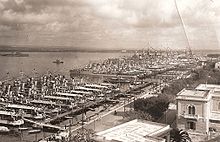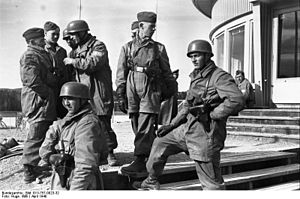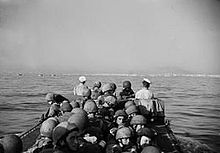- Operation Slapstick
-
Operation Slapstick Part of Allied invasion of Italy 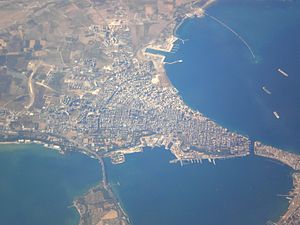
Aerial view of TarantoDate 9 September 1943 Location Taranto, Italy
40°28′15.53″N 17°14′10.23″E / 40.4709806°N 17.236175°EResult British success Belligerents  United Kingdom
United Kingdom Germany
GermanyCommanders and leaders George F. Hopkinson †
Ernest DownRichard Heidrich Units involved 1st Airborne Division
12th Cruiser Squadron1st Parachute Division Casualties and losses British Army
58 dead
154 wounded
Royal Navy
48 dead
HMS Abdiel sunkNone during initial landing The Field Ambulance units in the division treated 2,150 casualties, between the landing and being withdrawn. Not all of these were from the 1st Airborne Division.[1] Invasion of Sicily – Invasion of Italy – Armistice with Italy – Four days of Naples – Vatican Bombing – Volturno Line – Barbara Line – Bari Raid – Bernhardt Line – Moro – Ortona – Monte Cassino – Anzio – Trasimene Line – Ancona – Gothic Line – Battle of Garfagnana – Spring offensive 1945 – Argenta GapSecond World War British airborne forces operations1st Airborne Division
2nd Independent Parachute Brigade
Operation Biting · Operation Freshman · North Africa · Operation Turkey Buzzard · Operation Ladbroke · Operation Fustian · Operation Slapstick · Battle of Arnhem · Operation Doomsday
6th Airborne Division
Operation Deadstick · Operation Tonga · Battle of Merville Gun Battery · Operation Mallard · Battle of Bréville · Operation Varsity
Operation Hasty · Operation Rugby · Operation MannaOperation Slapstick was the code name for a British landing from the sea at the Italian port of Taranto during the Second World War. The operation, one of three landings during the Allied invasion of Italy, was undertaken by the British 1st Airborne Division in September 1943.
Planned at short notice, the mission followed an offer by the Italian government to open the ports of Taranto and Brindisi on the heel of Italy to the Allies. The airborne division was selected to undertake the mission, but at the time they were located in North Africa. A shortage of transport aircraft meant the division could not land in their traditional way by parachute and glider, and all the landing craft in the area were already allocated to the other landings: Operation Avalanche at Salerno on the western coast, and Operation Baytown at Calabria. Instead, the division had to be transported across the Mediterranean by ships of the Royal Navy. The landing was unopposed and the airborne division successfully captured the ports of Taranto, and later Brindisi on the Adriatic coast in working order.
The only German forces in the area were elements of the 1st Parachute Division (1. Fallschirmjäger Division),[note 1] which engaged the advancing British in ambushes and at roadblocks during a fighting withdrawal north. Eventually, by the end of September, the 1st Airborne Division advanced 125 miles (201 km) to Foggia. Reinforcements from two infantry divisions had by then been landed behind them, which allowed the airborne troops to be withdrawn to Taranto. Soon after, they sailed for England.
Contents
Background
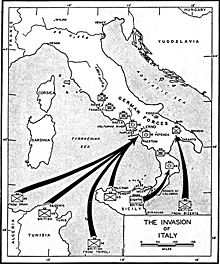 Locations of the Allied invasion of Italy.
Locations of the Allied invasion of Italy.
In May 1943, the Axis powers of Nazi Germany and Fascist Italy were defeated in the North African Campaign. Two months later, the Allied powers of Great Britain and the United States, successfully invaded Sicily. The island being completely occupied by the end of August, the Allies next turned their attention to the invasion of Italy.[3]
On 3 September 1943, the British Eighth Army crossed the Straits of Messina from Sicily and landed in Calabria during Operation Baytown to seize the ports of Reggio and San Giovanni.[4] The main invasion was planned for 9 September, with the US Fifth Army landing at Salerno on the western coast in Operation Avalanche, with Naples their immediate objective. The Allies hoped that the invasion would persuade the Italian forces to surrender. If they did, the five Italian divisions in France and the 29 in the Balkans would have to be replaced by German formations. Also, if the Germans then decided to continue the fight in Italy, they would have to redeploy some of their divisions engaged on the Eastern Front or on occupation duties in France.[5]
During secret surrender negotiations with the Allies in early September, the Italian government offered to open the ports of Taranto and Brindisi on the eastern coast.[6] German forces in that area were very weak and would be expected to withdraw rather than fight if the Allies landed there.[6] General Eisenhower, the Supreme Allied Commander, quickly planned a third landing, codenamed Slapstick, to take advantage of the offer.[6]
Slapstick was in part an operation of deception, to divert German forces away from the main Allied landings at Salerno on the same day, while also attempting to capture Taranto and Brindisi intact.[7] The main value of Taranto was its large port. Its seizure would, with the expected capture of Naples in the west by the Americans, give the Allies supply points on both Italian coasts.[8]
Taranto
First founded by the Spartans almost 3,000 years before, Taranto had been fought over numerous times. Combatants had ranged from the Arab and Byzantine empires to the Normans in the Middle Ages. It later became part of the Kingdom of Sicily and the Kingdom of Naples. After the unification of Italy, Taranto became the home of the Italian Navy.[9]
Taranto is also the capital city of the Province of Taranto in the region of Apulia and has a large dock area.[10] It includes the two islets of St. Peter and St. Paul, which protect the bay, called the Mar Grande (Big Sea), where the commercial port is located. The military port was located in another bay, the Mar Piccolo.[11]
As it was the base of the Italian Navy, in November 1940 Taranto was attacked by the Royal Navy in what became known as the Battle of Taranto. During the attack by carrier-borne aircraft, in one night, the Italian fleet lost around half its strength; the next day, their undamaged ships were transferred from Taranto to Naples to try to protect them from similar attacks.[10]
Prelude
German forces
The German High Command fully expected Italy to surrender and, in preparation, had secretly established a new Army Group headquarters commanded by Field Marshal Erwin Rommel at Munich. Rommel would have six divisions transferred from the Eastern Front, two divisions from France that had just been reformed, and two parachute divisions based in Germany in his new command. However, a Russian offensive in the east prevented the release of all the units promised. Adolf Hitler came to the conclusion that, without the backing of the Italian Army, it would be impossible for the Germans to defend the whole of Italy.[12]
In Italy, German Field Marshal Albert Kesselring, unaware of what was happening in Germany, had been building up the strength of his forces.[12] He was aided in this by the escape from Sicily of three divisions, which managed to cross the Straits of Messina without serious loss of men or equipment.[13] In August, five infantry and two panzer divisions moved into northern Italy.[14] After the loss of Sicily, Hitler amended the German plans, deciding to hold the Salerno-Naples area with five infantry divisions,[15] while the 1st Parachute Division was ordered to the Apulia region.[16]
Commanded by Major-General Richard Heidrich, the 1st Parachute Division consisted of the 1st, 3rd and 4th Parachute Regiments, with an artillery regiment, tank-destroyer, anti-aircraft, and engineer battalions, and other support units.[17] The division was the successor of the original German airborne force, the 7th Air Division, and was highly experienced. It had spearheaded the German invasion in the west in 1940, and fought in the battles of Greece and Crete, and in the Soviet Union.[18] Withdrawn from the Soviet Union in 1943, the division had already fought against British paratroops during operations in Sicily.[19] However, on 9 September only three combat battalions and the headquarters were in Apulia.[note 1]
British forces
Plans were formulated on 6 September to transport the 1st Airborne Division to Taranto from their base in North Africa.[13] They would take advantage of the Italian surrender to capture the port and establish anti-aircraft defences. What was left of the Italian fleet still using the harbour was expected to have left beforehand.[6] The Allies believed that the division would face only minimal opposition and would be able to overcome any resistance with the limited naval support available, as Taranto was outside the range of Allied fighter aircraft based in Sicily.[20]
Although it had been formed in 1941, the 1st Airborne Division, commanded by Major-General George F. Hopkinson, had never fought as a division. The only units with any combat experience were the 1st Parachute Brigade, which had fought as an independent brigade in North Africa and in Operation Fustian during the Allied invasion of Sicily,[21][22] and the 1st Airlanding Brigade which had also fought in Sicily during Operation Ladbroke.[22] Both brigades had suffered heavy casualties in Sicily and were in no condition to undertake any further assault landings.[23] Of the division's other brigades, the 2nd and 4th Parachute Brigades, were untried in battle. Also, the 2nd Parachute Brigade was the only full strength unit, the 4th Parachute Brigade having only two battalions while its third battalion was still forming in Palestine.[24]
There was only sufficient troop transport aircraft to support one division-sized operation, and that was allocated to the American 82nd Airborne Division as part of the Salerno landings.[25] As a result, the 1st Airborne Division had to be carried to Italy by sea.[7] With no landing craft available on such short notice, the division was carried across the Mediterranean by four cruisers, HMS Aurora, HMS Penelope, HMS Dido and HMS Sirius of the Royal Navy's 12th Cruiser Squadron,[26] accompanied by the minelayer HMS Abdiel and the American cruiser USS Boise, all commanded by Commodore W.G. Agnew.[27] If the landing was successful, the 78th Infantry Division in Sicily and the 8th Indian Infantry Division in the Middle East, would be sent to reinforce the airborne division, under the command of V Corps.[7][24]
Landing
Before leaving Tunisia, the 1st Airborne Division was divided into two halves. The first half, consisting of the divisional headquarters, the 1st and 4th Parachute Brigade groups and the 9th Field Company Royal Engineers, boarded the Royal Navy ships at Bizerta.[27] The ships departed at 17:00 on 8 September, their decks loaded with the division's vehicles and stores.[26] Admiral of the Fleet Andrew Cunningham was concerned that the Italian battle fleet based at Taranto might sortie and attack the cruisers which would be unable to defend themselves adequately, overloaded as they were with troops and equipment. He therefore ordered the battleships HMS Howe and HMS King George V and their six escorting destroyers, commanded by Vice Admiral Arthur Power, to leave their base in Malta and join the flotilla.[28] At 18:30 8 September, while the convoy was at sea, General Eisenhower broadcast the details of the Italian surrender.[29]
To support the British landings early on 9 September, Scanzano was attacked by American B-26 Marauders from the 17th and 310th Bombardment Groups.[30] Then, just as the Allied flotilla approached Taranto, the Italian battleships Andrea Doria and Caio Duilio and three cruisers were observed leaving the harbour. The flotilla went to action stations, but the Italian ships just sailed past them en route to Malta to surrender in accordance with the agreement between the Allies and the Italian government.[31] At 15:00, the flotilla reached the minefield guarding the entrance to Taranto. The destroyer escort HMS Javelin negotiated the minefield and entered the harbour. Two hours later, Javelin returned with an Italian harbour pilot on board. HMS Penelope and USS Boise were guided safely into the harbour and alongside the jetty, where they disembarked the troops they were carrying, while the other ships in the flotilla remained outside the port and used small ship's boats to take their soldiers ashore.[26] The port's facilities were all in working order and were soon unloading the ships.[32]
The first units ashore were the headquarters of the 4th Parachute Brigade and the 10th Parachute Battalion, which were directed to move inland to guard against a German attack.[33] When the airborne division troops entered the city, they were welcomed by the Italian defenders and informed that the German forces had already departed.[32] When the two brigades were offloaded, they passed through the city and set up defensive positions to the north.[26] At the same time, Hopkinson established his divisional headquarters in the Albergo Europa Hotel and accepted the Italian surrender from the military governor.[26]
After safely landing the first half of the division, the 12th Cruiser Squadron returned to Bizerta to collect the remaining troops, consisting of the 2nd Parachute Brigade, the 1st Airlanding Brigade and the Glider Pilot Regiment.[27] The only casualties in the landing occurred on 10 September when HMS Abdiel, while manoeuvring alongside the dock, struck a mine and sank. Casualties totaled 58 killed and 154 wounded from the 6th (Royal Welch) Parachute Battalion,[33] and 48 dead among Abdiel's crew.[34] Abdiel was also carrying twelve 6 pounder anti-tank guns of the 2nd Anti-tank Battery, and the division's reserve ammunition supply.[26]
Overnight, the 4th Parachute Brigade led the advance inland.[26] By daybreak on 10 September, they had reached Massafra, where they were welcomed by the population. The next town they reached was Mottola, which was still occupied by the Germans. The Germans put up some resistance to the 156th Parachute Battalion's assault, but withdrew soon after. The division's first combat casualties resulted from this action. The wounded were evacuated to Taranto, where the 133rd (Parachute) Field Ambulance had established an 80-bed main dressing station at the Rendinella hospital.[35]
The German paratroop rearguard tried to delay the British advance with several ambushes and roadblocks. At a roadblock beside the town of Castellaneta, Hopkinson was hit by a burst of German machine gun fire while observing the 10th Parachute Battalion's attack. He died of his wounds the following day.[36] Hopkinson was replaced as the divisional commander by Brigadier Ernest Down, previously the commander of the 2nd Parachute Brigade.[37]
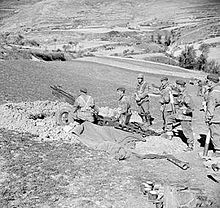 75 mm Howitzer of the 1st Airlanding Light Artillery Regiment in action in Italy.
75 mm Howitzer of the 1st Airlanding Light Artillery Regiment in action in Italy.
Within 48 hours of landing at Taranto, the airborne division reached and occupied the port of Brindisi and Bari on the Adriatic coast without opposition from the Italian defenders.[27][32] On 11 September on the division's left, contact was made with the 1st Canadian Infantry Division, the leading unit of the Eighth Army which had arrived in the area from Calabria.[38] By the evening of 12 September, the 1st Airborne Division had advanced 20 miles (32 km) inland on foot.[39]
The airborne division's next objective was now the airfield at Gioia del Colle. The Royal Air Force needed the airfield to bring in fighter aircraft from Sicily and support the landings at Salerno, which had not gone as expected.[40] The Germans continued their withdrawal, and Gioia was reached over the night of the 16/17 September, by the 10th and 156th Parachute Battalions.[41] The Royal Air Force took over the airfield and 48 hours later, six squadrons were flying from the base in support of Allied operations.[41][42] Between 20 and 24 September, the 1st Airborne Division was ordered to halt and construct defences on the approaches to Taranto, due to concerns that the Germans might launch a counter attack against the overextended unit.[41]
The V Corps headquarters landed at Taranto on 18 September and prepared for the arrival of its two divisions.[43] The first was the 78th Infantry Division, which started arriving at Bari on 22 September,[44] followed by the 8th Indian Infantry Division at Taranto the next day.[45] On 24 September, the 1st Parachute and 1st Airlanding Brigades took over the advance for the airborne division.[42] By 27 September, they and the 78th Division reached Foggia, 125 miles (201 km) from Taranto.[44] From there, the airborne division was withdrawn to Taranto. By November, most of the division had left for England.[42]
Aftermath
Operation Slapstick did not provide the diversion Eisenhower had hoped for. The decision by Heidrich not to oppose the landings was made without reference to Kesselring's headquarters. Heidrich had expected to be confronted by an overwhelming Allied force and had withdrawn his units north, although he endeavoured to delay the Allied advance where possible by ambushes and roadblocks.[32] The German division went on to frustrate the Allied attempt to advance on Rome during the Battle of Cassino in 1944.[17]
The British 1st Airborne Division only fought in one other battle during the war. Almost a year to the day, on 17 September 1944, they took part in Operation Market Garden, the airborne assault crossing of the River Rhine in the Netherlands.[46] Trapped behind German lines with their backs to the river and surrounded by parts of two panzer divisions, the division was virtually destroyed in the Battle of Arnhem; only 2,100 men of the 10,000 that had started the mission were evacuated south of the Rhine.[47]
Notes
- Footnotes
- ^ a b On 9 September HQ 1st Parachute Division had under command its 1st Parachute Regiment (less a battalion) plus a battalion of the 4th Parachute Regiment. Its 3rd and 4th Parachute Regiments (less detachment) were in Calabria under command of 26th Panzer Division while the 3rd Battalion of the 1st Parachute Regiment was in Naples under command of the Hermann Göring Division.[2]
- Citations
- ^ Cole, pp.55–56
- ^ Molony, p.243 (footnote 1).
- ^ Blumenson, p.23
- ^ Blumenson, pp.30–31
- ^ Blumenson, p.26
- ^ a b c d Blumenson, p.60
- ^ a b c Blumenson, p.94
- ^ Blumenson, p.113
- ^ "History of Taranto". Italia. http://www.italytravelescape.com/history-of-taranto.htm. Retrieved 3 July 2011.
- ^ a b Sturtivant, pp.48–50
- ^ Musciano, p.166
- ^ a b Blumenson, p.79
- ^ a b Cole, p.51
- ^ Blumenson, p.82
- ^ Blumenson, p.83
- ^ Blumenson, p.86
- ^ a b Mitcham, p.281
- ^ Micham, pp.291–292
- ^ Micham, p.281
- ^ Blumenson, p.33
- ^ Ferguson, p.9
- ^ a b Ferguson, p.11
- ^ Ferguson, p.13
- ^ a b Blumenson, p.95
- ^ Tugwell, p.168
- ^ a b c d e f g Cole, p.52
- ^ a b c d Chant, p.254
- ^ Morison, pp.235–236
- ^ Blumenson, p.73
- ^ Styling, p.25
- ^ Morison, p.256
- ^ a b c d Blumenson, p.114
- ^ a b Reynolds, p.37
- ^ Lamb, p.49
- ^ Cole, p.53
- ^ Harclerode, p.262
- ^ Otway, p.133
- ^ Blumenson, p.172
- ^ Cole, p.54
- ^ Cole, pp.54–55
- ^ a b c Cole, p.55
- ^ a b c Reynolds, p.38
- ^ Blumenson, p.173
- ^ a b Cavendish, p.17
- ^ Prasad, p.368
- ^ Ferguson, p.21
- ^ Ferguson, p.26
References
- Blumenson, Martin (1969). United States Army in World War 2, Mediterranean Theater of Operations, Salerno to Cassino. Washington DC: Defense Department Army, Government Printing Office. OCLC 631290895.
- Cavendish, Marshall (2010). Global Chaos World War II. World War II. New York: Marshall Cavendish Benchmark. ISBN 0761449485.
- Chant, Christopher (1986). The Encyclopaedia of Codenames of World War II. London: Routledge. ISBN 0710207182.
- Cole, Howard N (1963). On Wings of Healing: the Story of the Airborne Medical Services 1940–1960. Edinburgh: William Blackwood. OCLC 29847628.
- Ferguson, Gregor (1984). The Paras 1940–84. Volume 1 of Elite Series. Oxford, United Kingdom: Osprey Publishing. ISBN 0850455731.
- Harclerode, Peter (2005). Wings of War – Airborne Warfare 1918–1945. London: Weidenfeld and Nicolson. ISBN 0304367303.
- Lamb, Richard (1984). Montgomery in Europe 1943–1945. London: Buchan & Enright. ISBN 0907675042.
- Mitcham, Samuel W (2007). German Order of Battle, Volume 2: 291st–999th Infantry Divisions, Named Infantry Divisions, and Special Divisions in World War II. Stackpole Military History Series. Volume 2 of German Order of Battle. Mechanicsburg, PA: Stackpole Books. ISBN 0811734374.
- Molony, Brigadier C.J.C.; with Flynn, Captain F.C. (R.N.); Davies, Major-General H.L. & Gleave, Group Captain T.P. (2004) [1st. pub. HMSO:1973]. Butler, Sir James. ed. The Mediterranean and Middle East, Volume V: The Campaign in Sicily 1943 and The Campaign in Italy 3rd September 1943 to 31st March 1944. History of the Second World War, United Kingdom Military Series. Uckfield, UK: Naval & Military Press. ISBN 1845740696.
- Morrison, Samuel Eliot (2001). History of United States Naval Operations in World War II: Sicily, Salerno, Anzio, January 1943 – June 1944. Volume 9 of History of United States Naval Operations in World War II. Champaign, IL: University of Illinois Press. ISBN 0252070399.
- Musciano, Walter A (1994). Warbirds of the Sea: A History of Aircraft Carriers & Carrier-based Aircraft. Atglen, PA: Schiffer Publishing. ISBN 9780887405839.
- Otway, Lieutenant-Colonel T.B.H (1990). The Second World War 1939–1945 Army — Airborne Forces. London: Imperial War Museum. ISBN 0901627577.
- Prasad, Bisheshwar (1956). The Campaigns in the Western Theatre Official History of the Indian Armed Forces in the Second World War, 1939–1945. Calcutta: Combined Inter-Services Historical Section. OCLC 164872723.
- Reynolds, David (1998). Paras: An Illustrated History of Britain's Airborne Forces. Stroud, United Kingdom: Sutton Publishing. ISBN 0750920599.
- Sturtivant, Ray (1990). British Naval Aviation: the Fleet Air Arm 1917–1990. London: Arms and Armour Press Ltd. ISBN 0853689385.
- Styling, Mark (2008). B-26 Marauder Units of the MTO. Volume 73 of Osprey Combat Aircraft. Oxford, United Kingdom: Osprey Publishing. ISBN 1846033071.
- Tugwell, Maurice (1971). Airborne to Battle: A History of Airborne Warfare, 1918–1971. London, United Kingdom: Kimber. ISBN 0718302621.
Categories:- World War II operations and battles of the Italian Campaign
- Italian Campaign
- Battles and operations of World War II involving Germany
- Battles and operations of World War II involving the United Kingdom
- Airborne warfare
- Parachute Regiment (United Kingdom)
- 1943 in Italy
- Conflicts in 1943
Wikimedia Foundation. 2010.

